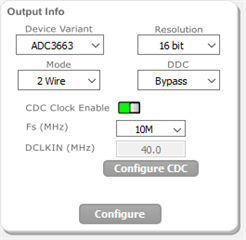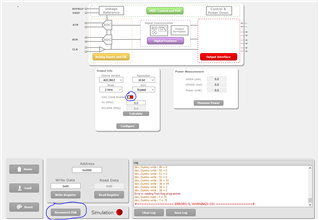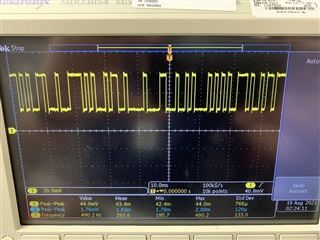Other Parts Discussed in Thread: ADC3663, CDCE6214, ADC3643EVM, ADC3643
Dear TI Team,
I am currently struggling with the start-up of an ADC3663EVM board connected to a TSW1400.
While the TSW1400 is properly starting-up and prompting a firmware flashing in HDSC, which appears to be performed without any error message, the ADC3663EVM is not recognized by the ADC35XX EVM GUI.
I performed the hardware modifications to use onboard clocking as instructed in page 20 of the user manual, but still the PLL_LOCKING diode remains off when I connect the board via USB and after "flashing" with the TSW1400.
I tried doing the same without flashing through the TSW1400 first, but I still get the error log attached to this post :
Device Reg Programmer - Cannot detect USB Instrument at address ADC35XX_1 A. Traceback printed below. Traceback (most recent call last): File "core\instrument\mInstrumentController.py", line 182, in __init__ Error: (2, 'Device not found.') Got an error Connecting to hardware. Running in Simulation Mode. No RegProgrammer defined Got an error Connecting to hardware. Running in Simulation Mode. ADC35XX - Device registers reset. dev, Dummy write : 0 = 1 dev, Dummy write : 0 = 0 dev, Dummy write : 8 = 0 dev, Dummy write : 17 = 0 dev, Dummy write : 7 = 8 dev, Dummy write : 7 = 72 dev, Dummy write : 19 = 1 dev, Dummy write : 19 = 0 dev, Dummy write : 7 = 75 dev, Dummy write : 25 = 2 dev, Dummy write : 31 = 16 dev, Dummy write : 31 = 80 dev, Dummy write : 10 = 8 dev, Dummy write : 11 = 0 dev, Dummy write : 12 = 0 dev, Dummy write : 24 = 16 dev, Dummy write : 25 = 18 dev, Dummy write : 32 = 0 dev, Dummy write : 33 = 252 dev, Dummy write : 34 = 15 dev, Dummy write : 25 = 18 dev, Dummy write : 25 = 18 dev, Dummy write : 27 = 128 dev, Dummy write : 27 = 136 dev, Dummy write : 36 = 0 dev, Dummy write : 36 = 0 dev, Dummy write : 36 = 0 dev, Dummy write : 36 = 0 dev, Dummy write : 39 = 0 dev, Dummy write : 46 = 0 dev, Dummy write : 39 = 0 dev, Dummy write : 46 = 0 dev, Dummy write : 37 = 0 dev, Dummy write : 37 = 0 dev, Dummy write : 37 = 0 dev, Dummy write : 42 = 0 dev, Dummy write : 43 = 0 dev, Dummy write : 44 = 0 dev, Dummy write : 45 = 0 dev, Dummy write : 49 = 0 dev, Dummy write : 50 = 0 dev, Dummy write : 51 = 0 dev, Dummy write : 52 = 0 dev, Dummy write : 38 = 32 dev, Dummy write : 38 = 34 dev, Dummy write : 38 = 2 dev, Dummy write : 38 = 0 Error in reading from Reg programmer dev, Dummy read : 7 = 75 dev, Dummy write : 7 = 75 dev, Dummy write : 8 = 0 dev, Dummy write : 17 = 0 dev, Dummy write : 8 = 0 dev, Dummy write : 17 = 0 dev, Dummy write : 7 = 75 dev, Dummy write : 7 = 75 dev, Dummy write : 19 = 1 dev, Dummy write : 19 = 0 dev, Dummy write : 7 = 75 dev, Dummy write : 25 = 18 dev, Dummy write : 31 = 80 dev, Dummy write : 31 = 80 dev, Dummy write : 10 = 8 dev, Dummy write : 11 = 0 dev, Dummy write : 12 = 0 dev, Dummy write : 24 = 16 dev, Dummy write : 25 = 18 dev, Dummy write : 32 = 0 dev, Dummy write : 33 = 252 dev, Dummy write : 34 = 15 dev, Dummy write : 25 = 18 dev, Dummy write : 25 = 18 dev, Dummy write : 27 = 136 dev, Dummy write : 27 = 136 dev, Dummy write : 36 = 0 dev, Dummy write : 36 = 0 dev, Dummy write : 36 = 0 dev, Dummy write : 36 = 0 dev, Dummy write : 39 = 0 dev, Dummy write : 46 = 0 dev, Dummy write : 39 = 0 dev, Dummy write : 46 = 0 dev, Dummy write : 37 = 0 dev, Dummy write : 37 = 0 dev, Dummy write : 37 = 0 dev, Dummy write : 42 = 0 dev, Dummy write : 43 = 0 dev, Dummy write : 44 = 0 dev, Dummy write : 45 = 0 dev, Dummy write : 49 = 0 dev, Dummy write : 50 = 0 dev, Dummy write : 51 = 0 dev, Dummy write : 52 = 0 dev, Dummy write : 38 = 32 dev, Dummy write : 38 = 34 dev, Dummy write : 38 = 2 dev, Dummy write : 38 = 0 Error in reading from Reg programmer dev, Dummy read : 7 = 75 dev, Dummy write : 7 = 75 #================ ERRORS:6, WARNINGS:153 ================#
I attempted to perform the same operations on another computer, to no avail.
My GUI configuration is the following :

Could you please help me on that topic ?
Thank you.




